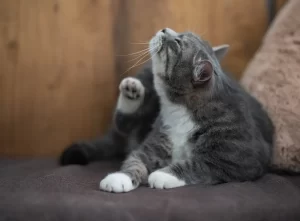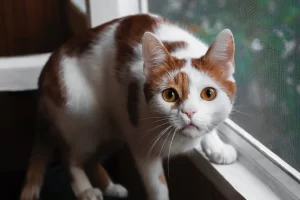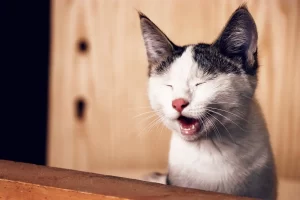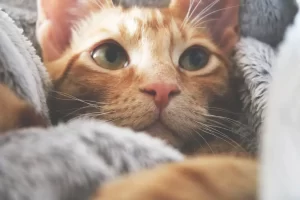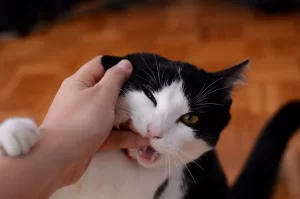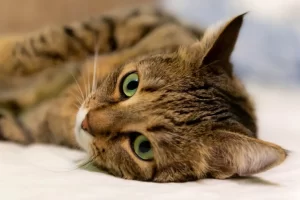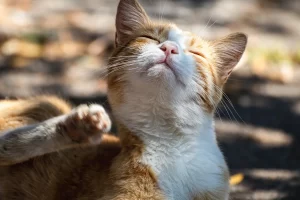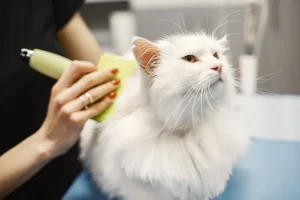As a cat owner, you may notice your furry friend experiencing hair loss, which can be a concerning and uncomfortable experience for both you and your pet. However, before you rush to the veterinarian, there are several home treatments for cat hair loss that you can try. Hair loss in cats can be caused by various factors, including allergies, parasites, hormonal imbalances, and stress. Understanding the underlying cause is crucial to determining the most effective home treatment for your cat. In this article, we will discuss fifteen essential topics related to home treatment for cat hair loss, including diet and nutrition, grooming and hygiene, parasite control, allergy management, herbal remedies, and medical treatments, among others. By following these tips and techniques, you can help your cat regain their beautiful coat and enjoy a happy and healthy life.
Table of Contents
ToggleCauses of Alopecia (Cat Hair Loss)
Cat hair loss, also known as alopecia, can be caused by a variety of factors. Here are some common reasons why cats may experience hair loss:
- Allergies: Cats can develop allergies to various environmental factors, such as pollen, dust, or certain types of food. Allergies can cause itching and irritation, which can lead to hair loss in affected areas.
- Parasites: Fleas, ticks, lice, and mites can all cause hair loss in cats. These parasites feed on the cat’s blood and cause irritation and itching, which can lead to hair loss and skin damage.
- Hormonal imbalances: Hormonal imbalances, such as an overactive thyroid gland or adrenal gland disease, can cause hair loss in cats. These conditions affect the cat’s metabolism and can cause changes in the skin and coat.
- Stress: Cats can experience stress from changes in their environment, such as moving to a new home or the introduction of a new pet. Stress can cause hair loss due to excessive grooming, which can lead to bald spots and skin irritation.
- Fungal or bacterial infections: Fungal or bacterial infections of the skin can cause hair loss in cats. These infections can be caused by various microorganisms, such as ringworm or staphylococcus.
- Cancer: Certain types of cancer, such as lymphoma, can cause hair loss in cats. Hair loss may occur in the affected area or all over the body.
- Trauma: Trauma, such as scratches or bites from other animals, can cause hair loss in cats. The affected area may become inflamed or infected, leading to hair loss.
- Aging: As cats age, their skin and coat may become thinner and less elastic, leading to hair loss.
Symptoms of Cat Hair Loss
Here are some signs and symptoms of hair loss in cats:
- Bald patches: The most obvious symptom of hair loss in cats is the presence of bald patches on the skin. These patches can be circular or irregular in shape and may be accompanied by redness or scaling.
- Excessive shedding: Cats naturally shed their fur, but excessive shedding can be a sign of hair loss. If you notice clumps of fur on your cat’s bedding, furniture, or clothing, it may be a sign of excessive shedding and hair loss.
- Skin irritation: Hair loss in cats can cause skin irritation and itching, which may lead to excessive scratching, licking, or biting. This can further aggravate the skin and worsen the hair loss.
- Crusts or scabs: In some cases, hair loss in cats may be accompanied by the formation of crusts or scabs on the skin. These can be caused by bacterial or fungal infections or by the cat’s excessive grooming.
- Changes in skin color or texture: Hair loss can cause changes in the color or texture of the skin. The skin may appear thicker or thinner than usual, and may have a rough or scaly texture.
- Behavioral changes: Cats experiencing hair loss may become more irritable or restless than usual. They may also spend more time grooming themselves, which can further worsen the hair loss.
- Other related symptoms: Hair loss in cats may be accompanied by other related symptoms, such as lethargy, loss of appetite, or weight loss. These symptoms may indicate an underlying health condition that requires veterinary attention.
Home Remedies for Cat Hair Loss
While it’s important to consult with a veterinarian to determine the underlying cause of your cat’s hair loss and to develop an appropriate treatment plan, there are some home remedies that may help improve your cat’s condition. Here are some natural remedies that cat owners can try to help improve their cat’s hair loss:
- Coconut oil: Coconut oil is a natural moisturizer that can help soothe dry, itchy skin and promote hair regrowth. To use, simply apply a small amount of coconut oil to your cat’s skin and coat, massaging it in gently.
- Fish oil: Fish oil is rich in omega-3 fatty acids, which can help improve skin health and promote hair regrowth. You can give your cat a fish oil supplement or add a small amount of fish oil to their food.
- Aloe vera: Aloe vera is a natural anti-inflammatory and can help soothe skin irritation and promote hair regrowth. Apply a small amount of aloe vera gel to your cat’s skin, avoiding the eyes and mouth.
- Apple cider vinegar: Apple cider vinegar has antibacterial and antifungal properties and can help control yeast and bacterial infections that may be contributing to your cat’s hair loss. Mix a small amount of apple cider vinegar with water and use a cotton ball to apply it to your cat’s skin.
- Chamomile tea: Chamomile tea has soothing properties and can help relieve itching and inflammation. Brew a cup of chamomile tea and let it cool, then apply it to your cat’s skin using a cotton ball.
- Oatmeal: Oatmeal has natural anti-inflammatory properties and can help soothe irritated skin. Cook plain oatmeal according to the package instructions and let it cool, then apply it to your cat’s skin and leave it on for 10-15 minutes before rinsing off.
- Vitamin E: Vitamin E is an antioxidant that can help improve skin health and promote hair regrowth. You can give your cat a vitamin E supplement or add a small amount of vitamin E oil to their food.
- Brewer’s yeast: Brewer’s yeast is rich in B vitamins and can help improve skin and coat health. You can sprinkle a small amount of brewer’s yeast on your cat’s food.
- Witch hazel: Witch hazel has astringent properties and can help reduce inflammation and soothe skin irritation. Mix witch hazel with water and use a cotton ball to apply it to your cat’s skin.
- Olive oil: Olive oil is a natural moisturizer that can help soothe dry skin and promote hair regrowth. Apply a small amount of olive oil to your cat’s skin and coat, massaging it in gently.
Best Food for Cat Hair Loss: The Importance of Diet and Nutrition
Proper nutrition is essential for maintaining healthy skin and coat in cats. Here are some tips and suggestions for ensuring your cat is getting the right nutrients:
- Protein: Cats are obligate carnivores, which means they require a high-protein diet to thrive. Make sure your cat’s diet includes a good source of animal-based protein, such as chicken, turkey, beef, or fish. Avoid plant-based proteins, which are less digestible for cats.
- Fatty acids: Omega-3 and omega-6 fatty acids are important for skin and coat health. Look for cat foods that contain sources of these essential fatty acids, such as fish oil, flaxseed, or chicken fat. You can also add a fish oil supplement to your cat’s diet.
- Vitamins and minerals: Cats require a variety of vitamins and minerals for overall health, including vitamin A, vitamin E, zinc, and biotin. Look for cat foods that contain these nutrients or consider adding a vitamin and mineral supplement to your cat’s diet.
- Hydration: Adequate hydration is important for maintaining healthy skin and coat. Make sure your cat has access to fresh, clean water at all times, and consider feeding wet food in addition to or instead of dry food.
- Avoid fillers and additives: Many commercial cat foods contain fillers and additives that provide little nutritional value and may even be harmful to your cat’s health. Look for high-quality, grain-free cat foods that prioritize animal-based protein and natural ingredients.
Cat Grooming and Hygiene Tips to Prevent Hair Loss
Regular grooming and hygiene practices can help promote healthy skin and coat in cats, which can in turn reduce the risk of hair loss. Here are some tips on how to properly groom and clean your cat:
- Brushing: Regular brushing can help remove loose hair, prevent matting, and distribute natural oils throughout your cat’s coat. Use a brush or comb specifically designed for cats, and be gentle to avoid irritating their skin. Depending on your cat’s coat type and length, you may need to brush them daily or weekly.
- Nail trimming: Overgrown nails can cause discomfort and even lead to infections or injuries. Use a cat-specific nail clipper to trim your cat’s nails, being careful not to cut into the quick (the pink part of the nail that contains blood vessels). If you’re unsure how to trim your cat’s nails, ask your veterinarian or a professional groomer for guidance.
- Bathing: While cats are generally fastidious groomers and do not require frequent baths, occasional bathing with a mild, cat-specific shampoo can help remove dirt and debris and promote a healthy coat. Use lukewarm water and avoid getting water in your cat’s ears or eyes. Rinse thoroughly and dry your cat with a towel or blow dryer set on low.
- Ear cleaning: Cats can be prone to ear infections and buildup of wax and debris in their ears. Use a cat-specific ear cleaning solution and a cotton ball or soft cloth to gently clean the outer ear flap and ear canal. Do not insert anything into the ear canal, as this can cause injury or infection.
- Dental care: Dental disease can not only cause bad breath and tooth loss, but can also affect overall health. Regular dental care, such as brushing your cat’s teeth with a cat-specific toothbrush and toothpaste, can help prevent dental disease.
Managing Parasites in Cats: A Guide to Preventing Hair Loss
Parasites such as fleas, mites, and lice can cause skin irritation and inflammation, leading to hair loss in cats. Here are some tips on how to prevent and treat these common parasites:
- Fleas: Fleas are small, wingless insects that can infest your cat’s fur and skin. They can cause itching, redness, and hair loss, and can also transmit diseases. To prevent fleas, use a flea preventive medication recommended by your veterinarian, and vacuum your home frequently to remove flea eggs and larvae. To treat an existing flea infestation, use a flea comb to remove adult fleas from your cat’s coat, and consider a flea medication or shampoo specifically designed to kill fleas.
- Mites: Mites are microscopic arachnids that can live on your cat’s skin and hair follicles. They can cause intense itching, hair loss, and scabs, and can also transmit diseases. To prevent mites, keep your cat’s living environment clean and avoid contact with other infested animals. To treat mites, your veterinarian may prescribe a medication or topical treatment specifically designed to kill the type of mite affecting your cat.
- Lice: Lice are small, wingless insects that can infest your cat’s fur and skin. They can cause itching, hair loss, and scabs, and can also transmit diseases. To prevent lice, avoid contact with infested animals and keep your cat’s living environment clean. To treat lice, your veterinarian may prescribe a medication or topical treatment specifically designed to kill lice.
By regularly checking your cat for signs of parasites and taking preventive measures, you can help prevent hair loss and other health issues caused by these common pests.
Allergy Relief for Cats: Strategies to Combat Hair Loss and Skin Irritation
Allergies can cause skin irritation and hair loss in cats. Here are some tips on how to manage and reduce your cat’s exposure to common allergens:
- Dust and pollen: To reduce your cat’s exposure to dust and pollen, keep your home clean and dust-free. Use an air purifier to help remove airborne allergens from the air, and avoid using scented candles or air fresheners that can trigger allergies. If your cat spends time outdoors, try to limit their exposure to pollen by keeping them indoors during peak allergy seasons.
- Food allergies: Food allergies can cause skin irritation, itching, and hair loss in cats. To identify and manage food allergies, try switching your cat’s diet to a limited ingredient or hypoallergenic food. Look for a food that contains a single protein source and a simple carbohydrate, such as duck and sweet potato, to help reduce the risk of triggering an allergic reaction. You can also try an elimination diet, where you gradually introduce new foods to your cat to help identify any potential allergens.
- Flea allergies: Flea bites can cause an allergic reaction in some cats, leading to hair loss and skin irritation. To prevent flea allergies, use flea prevention products and keep your home and cat’s bedding clean. If your cat has a flea allergy, your vet may recommend a topical or oral medication to help reduce the itching and inflammation.
Preventing Stress Hair Loss in Cats
Stress and anxiety can lead to hair loss and other health issues in cats. Here are some tips on how to manage stress and create a calm environment for your cat:
- Provide a safe space: Cats need a quiet and safe space to retreat to when they feel stressed or anxious. Create a cozy hiding spot for your cat, such as a comfortable bed in a quiet room or a covered crate, where they can retreat when they feel overwhelmed.
- Use calming pheromones: Feliway is a synthetic version of a pheromone that cats produce naturally when they feel safe and relaxed. Feliway can be used as a spray or diffuser to help calm cats and reduce stress and anxiety.
- Playtime and exercise: Regular playtime and exercise can help reduce stress and anxiety in cats. Provide your cat with interactive toys, such as feather wands or puzzle toys, and make time for daily play sessions.
- Routine and consistency: Cats thrive on routine and consistency, so try to keep their daily routine as consistent as possible. Feed your cat at the same time each day, and provide a regular sleep and play schedule to help reduce stress and anxiety.
Understanding Medications for Cat Hair Loss
When it comes to treating hair loss in cats, your veterinarian may prescribe various medications depending on the underlying cause. Here are some common medications that may be prescribed:
- Antihistamines: If your cat’s hair loss is caused by allergies, your veterinarian may prescribe antihistamines to help reduce the allergic reaction. Some common antihistamines for cats include diphenhydramine (Benadryl) and chlorpheniramine (Chlor-Trimeton).
- Antibiotics: If your cat has a bacterial infection that is causing hair loss, your veterinarian may prescribe antibiotics to treat the infection. Common antibiotics for cats include amoxicillin, clavulanic acid, and enrofloxacin.
- Steroids: If your cat has an autoimmune disease or inflammation that is causing hair loss, your veterinarian may prescribe steroids to help reduce inflammation and restore hair growth. Common steroids for cats include prednisone and dexamethasone.
- Topical treatments: Your veterinarian may also prescribe topical treatments, such as medicated shampoos, creams, or sprays, to help treat skin conditions that are causing hair loss.
Herbal Remedies for Cat Hair Loss
Below are some herbal remedies that can help promote healthy skin and coat in cats:
- Chamomile: Chamomile is a natural anti-inflammatory and antiseptic herb that can help soothe irritated skin and reduce inflammation. To use chamomile for your cat’s skin, you can make a tea from dried chamomile flowers and use it as a rinse after bathing your cat. Alternatively, you can apply a chamomile tea bag directly to any irritated areas.
- Calendula: Calendula is a natural wound-healing herb that can help soothe irritated skin and promote skin regeneration. You can make a calendula-infused oil by steeping dried calendula flowers in olive oil for a few weeks, then straining out the flowers. This oil can be applied topically to your cat’s skin to promote healing.
- Nettle: Nettle is a natural anti-inflammatory herb that can help reduce inflammation and itching in cats with skin conditions. To use nettle for your cat’s skin, you can make a tea from dried nettle leaves and use it as a rinse after bathing your cat. Alternatively, you can add nettle leaves to your cat’s food as a supplement.
Note that while these herbs are generally considered safe for cats, it’s always best to consult with your veterinarian before using any herbal remedies on your cat.
The Benefits of Supplement for Cat Hair Loss
Supplements that can help improve your cat’s skin and coat health are:
- Omega-3 fatty acids: Omega-3 fatty acids, such as those found in fish oil, can help reduce inflammation and improve skin and coat health in cats. You can add fish oil to your cat’s food as a supplement, following the manufacturer’s recommended dosage.
- Probiotics: Probiotics can help support your cat’s digestive and immune health, which can in turn improve their skin and coat health. You can give your cat probiotic supplements or add probiotic-rich foods, such as kefir or yogurt, to their diet.
- Vitamin E: Vitamin E is an antioxidant that can help protect your cat’s skin and coat from damage. You can give your cat vitamin E supplements or add vitamin E-rich foods, such as almonds or sunflower seeds, to their diet.
- Biotin: Biotin is a B vitamin that can help improve your cat’s coat quality and promote hair growth. You can give your cat biotin supplements or add biotin-rich foods, such as egg yolks or liver, to their diet.
Home Care Tips for Cats with Hair Loss
Here are some practical tips for caring for a cat experiencing hair loss at home:
- Keep their bedding clean: Regularly washing your cat’s bedding can help prevent the buildup of bacteria and allergens that can irritate their skin and cause hair loss. Use a gentle, unscented detergent and avoid fabric softeners, which can contain harsh chemicals.
- Avoid harsh chemicals: Harsh chemicals found in cleaning products, insecticides, and other household products can be irritating to your cat’s skin and exacerbate hair loss. Opt for natural, non-toxic alternatives whenever possible.
- Use a humidifier: Dry air can cause your cat’s skin to become dry and itchy, which can contribute to hair loss. Using a humidifier can help keep the air in your home moist and improve your cat’s skin health.
- Provide a balanced diet: A balanced diet is essential for maintaining your cat’s skin and coat health. Make sure their diet includes high-quality protein and a variety of vitamins and minerals. Avoid feeding your cat human food, which can be high in fat and lacking in essential nutrients.
- Be gentle when grooming: When grooming your cat, be gentle to avoid further irritating their skin. Use a soft-bristled brush and avoid pulling or tugging on their hair.
- Don’t over-bathe your cat: While bathing your cat can help remove dirt and allergens from their skin, over-bathing can strip their skin of natural oils and exacerbate hair loss. Only bathe your cat when necessary, using a gentle, moisturizing shampoo.
- Don’t apply human products to your cat: Products designed for humans, such as lotions or hair products, can be harmful to your cat’s skin and should not be used.
How Is The Cat Hair Loss Diagnosed?
If you suspect that your cat is experiencing hair loss, it’s important to take them to the veterinarian for a proper diagnosis. Here are some common diagnostic tests that veterinarians use to determine the underlying causes of hair loss in cats:
- Physical examination: The veterinarian will perform a thorough physical examination of your cat, looking for any signs of skin irritation, infection, or other abnormalities.
- Blood tests: Blood tests can help detect any underlying health conditions that may be causing hair loss, such as thyroid or adrenal gland disease.
- Skin scrapings: Skin scrapings can be taken to check for the presence of mites or other parasites that may be causing hair loss.
- Biopsy: In some cases, a skin biopsy may be necessary to determine the underlying cause of hair loss. A small sample of skin tissue is taken and examined under a microscope to identify any abnormalities.
- Allergy testing: If allergies are suspected, allergy testing may be performed to identify the specific allergens that are causing the reaction.
- Hormone testing: Hormone testing may be performed to check for any hormonal imbalances that may be causing hair loss.
- Fungal culture: If a fungal infection is suspected, a culture may be taken to identify the specific type of fungus and determine the appropriate treatment.


